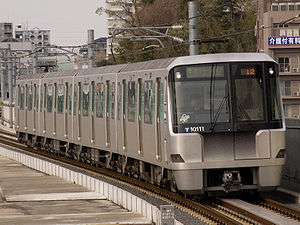Yokohama Municipal Subway 10000 series
| Yokohama Municipal Subway 10000 series | |
|---|---|
 Set 10111 in April 2008 | |
| Manufacturer | Kawasaki Heavy Industries |
| Built at | Kobe, Hyogo |
| Constructed | 2007- |
| Entered service | March 2008 |
| Number built | 68 vehicles (17 sets) |
| Number in service | 68 vehicles (17 sets) |
| Formation | 4 cars per trainset |
| Capacity | 380 (136 seated) per 4-car set |
| Operator(s) | Yokohama Municipal Subway |
| Depot(s) | Kawawa |
| Line(s) served | Yokohama Municipal Subway Green Line |
| Specifications | |
| Car body construction | Aluminium |
| Car length | 15,600 mm (51 ft 2 in) (end cars), 15,000 mm (49 ft 3 in) (intermediate cars) |
| Width | 2,490 mm (8 ft 2 in) |
| Height | 3,120 mm (10 ft 3 in) |
| Floor height | 840 mm (2 ft 9 in) |
| Doors | 3 pairs per side |
| Maximum speed | 80 km/h (50 mph) |
| Weight | 26.5 t (end cars) 26.0 t (intermediate cars) |
| Acceleration | 3.2 km/h/s |
| Deceleration | 3.5 km/h/s (4.5 km/h/s for emergency brake) |
| Electric system(s) | 1,500 V DC |
| Current collection method | Overhead lines |
| Track gauge | 1,435 mm (4 ft 8 1⁄2 in) standard gauge |
The Yokohama Municipal Subway 10000 series (横浜市交通局10000形) is a linear-motor-powered electric multiple unit (EMU) operated by the Yokohama Municipal Subway on the Yokohama Municipal Subway Green Line since March 2008.
Formation
As of 1 April 2017, the fleet consists of 17 four-car sets with all cars motored, and formed as shown below with car 1 at the Nakayama end.[1] The sets are designed to allow the insertion of two centre cars at a later date, hence the numbering sequence that omits cars 3 and 4.
| Car No. | 1 | 2 | 3 | 4 |
|---|---|---|---|---|
| Designation | Mc1 | M2 | M5 | Mc6 |
| Numbering | 10xx1 | 10xx2 | 10xx5 | 10xx6 |
| Weight (t) | 26.5 | 26.0 | 26.0 | 26.5 |
| Capacity (total/seated) | 88/31 | 102/37 | 102/37 | 88/31 |
- "xx" indicates the individual set number.
- Cars 1 and 4 are each fitted with one single-arm pantograph.[1]
- Car 3 is designated as a mildly air-conditioned car.[1]
Interior
Passenger accommodation consists of longitudinal bench seating throughout.[2] Wheelchair spaces are provided in each car.[1]
 A train interior in January 2008
A train interior in January 2008
History
The first two pre-production sets, 10011 and 10021 were completed in May 2007 and shipped to Yokohama, arriving in June. The first full-production set, 10031, was delivered in July 2007, being hauled via JR tracks from the Kawasaki factory in Hyōgo Prefecture. The full-production sets feature a number of minor design improvements, including green-coloured gradations externally instead of the blue gradations used on the first two sets.
The trains entered service from 30 March 2008 with the opening of the Green Line.[1]
Two second-batch four-car sets were introduced from the start of the revised timetable on 29 March 2014.[3] These sets feature LED headlights, full-colour LED destination indicators, interior LED lighting, and 17-inch LCD passenger information displays.[3]
Future plans
In 2018, it was announced that ten of the 17 sets in operation would be lengthened to six cars each by 2024 as a measure to ease overcrowding on the Green Line.[4]
Special liveries
From 25 February 2018, set 10161 began operating in a special cream and green vinyl wrapping livery based on the livery carried by former Yokohama city tramcars to mark the tenth anniversary of the opening of the Green Line.[5]
References
| Wikimedia Commons has media related to Yokohama Municipal Subway 10000 series. |
- 1 2 3 4 5 私鉄車両編成表 2017 私鉄車両編成表 2017 [Private Railway Rolling Stock Formations - 2017] (in Japanese). Japan: Kotsu Shimbunsha. 25 July 2017. p. 83. ISBN 978-4-330-81317-2.
- ↑ 横浜市交通局10000形2次車量産車 [Yokohama Municipal Subway 10000 series full-production sets]. Japan Railfan Magazine (in Japanese). Vol. 48 no. 561. Japan: Koyusha Co., Ltd. January 2008. pp. 62–63.
- 1 2 横浜市交通局10000形2次車 [Yokohama Municipal Subway 10000 series 2nd-batch sets]. Japan Railfan Magazine (in Japanese). Vol. 54 no. 638. Japan: Koyusha Co., Ltd. June 2014. pp. 78–79.
- ↑ 横浜市グリーンラインに大型投資 混雑緩和へ6両化 [Large-scale investment on Yokohama Municipal Green Line - Lengthening to 6 cars to ease overcrowding]. Kanaloco (in Japanese). Japan: Kanagawa Shimbun. 30 January 2018. Archived from the original on 31 January 2018. Retrieved 31 January 2018.
- ↑ 横浜市交「グリーンライン10周年記念装飾列車」運転 [Yokohama Municipal Subway "Green Line 10th Anniversary Livery Train" enters service]. Japan Railfan Magazine Online (in Japanese). Japan: Koyusha Co., Ltd. 26 February 2018. Archived from the original on 27 February 2018. Retrieved 27 February 2018.